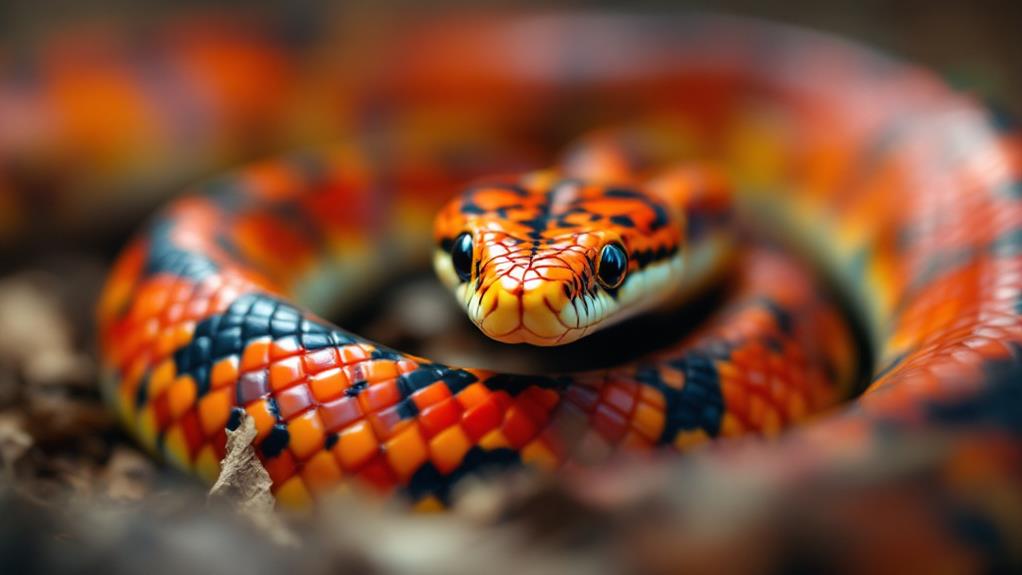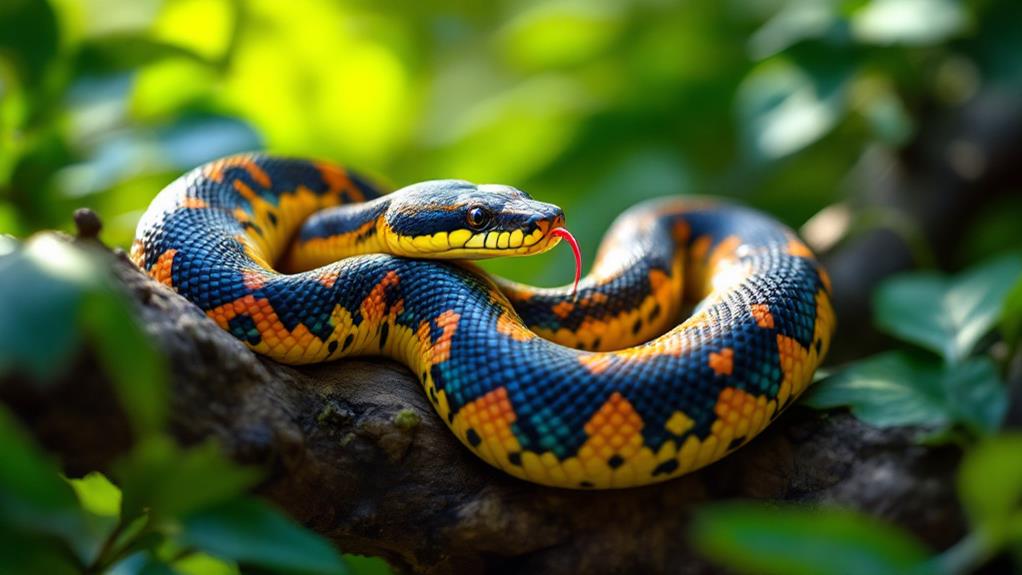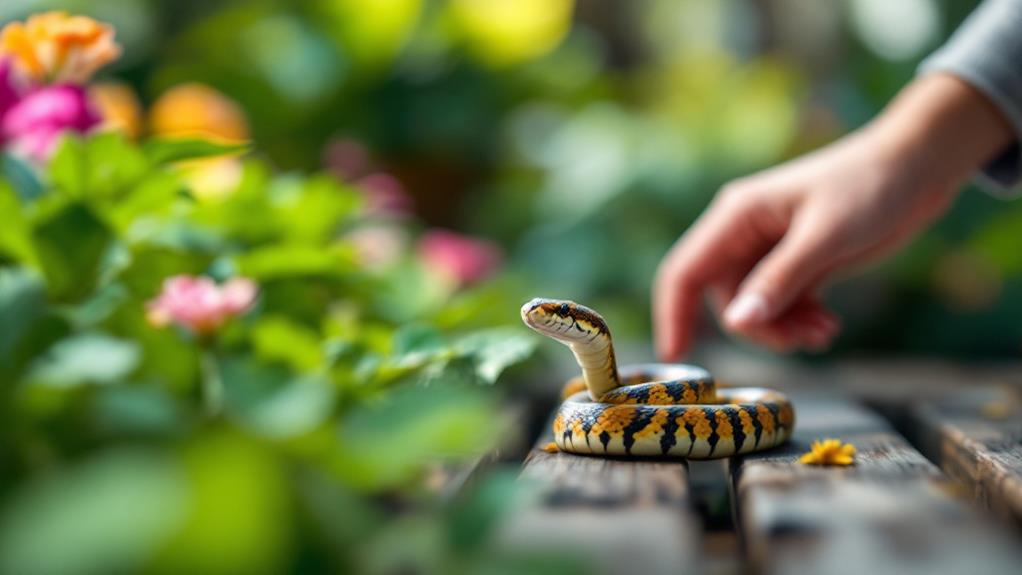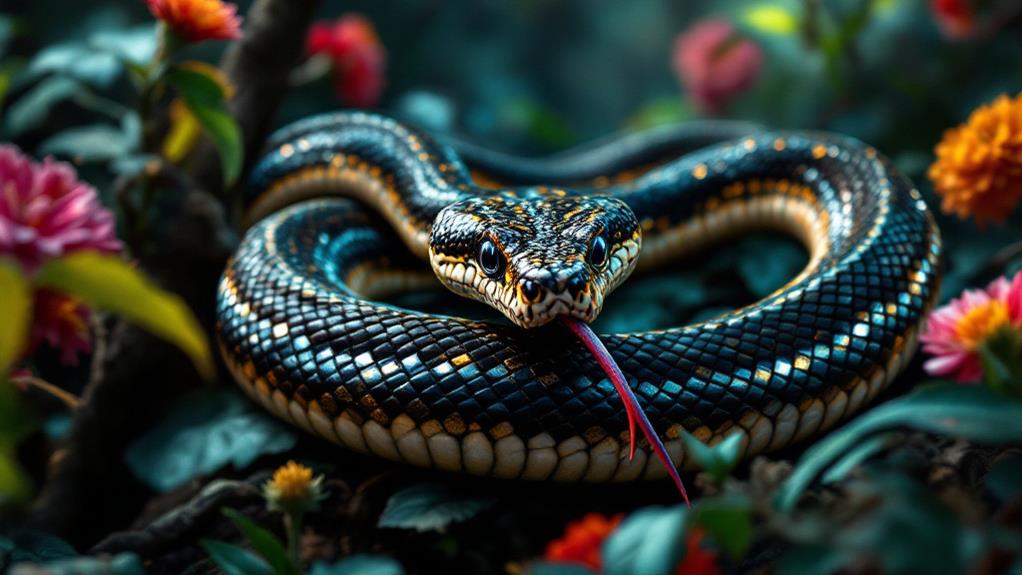Non-Venomous Snake Species: A Guide to Harmless Snakes

Non-venomous snakes make up most snake species worldwide, offering fascinating diversity without the danger of venom. Popular harmless species include corn snakes, ball pythons, and garter snakes. You can identify them by their round pupils, slender heads, and smooth scales. These snakes play pivotal roles in ecosystems, controlling pests and maintaining biodiversity. They're generally shy and prefer to flee rather than confront humans. Common myths about snakes, like having slimy skin or unhinging jaws, are unfounded. By understanding these gentle creatures, you'll gain a new appreciation for their importance and beauty. Explore more about these misunderstood reptiles and how to coexist with them safely.
Common Non-Venomous Snake Species
Throughout the world, you'll find a wide variety of non-venomous snake species. Some of the most common include the corn snake, ball python, and garter snake. These species are popular among reptile enthusiasts due to their docile nature and relatively easy care requirements.
Corn snakes, native to North America, are known for their vibrant colors and patterns. They prefer forested areas and are excellent climbers. Ball pythons, originating from Africa, are ground-dwelling and thrive in grasslands and savannas. Garter snakes are widespread across North America and adapt well to various habitats, from forests to urban areas.
When it comes to snake feeding requirements, corn snakes primarily eat small rodents, while ball pythons consume rats and mice. Garter snakes have a more diverse diet, including fish, amphibians, and earthworms. It's crucial to understand each species' specific needs to provide proper care.
Other common non-venomous snakes include the king snake, rat snake, and rosy boa. These species have unique snake habitat preferences, ranging from desert environments to wooded areas. By learning about these harmless snakes, you can appreciate their role in ecosystems and potentially consider them as pets.
Identifying Harmless Snakes
While many people fear snakes, learning to identify harmless species can help alleviate unnecessary anxiety. To distinguish non-venomous snakes, focus on key physical characteristics. Look for round pupils and a slender head that's only slightly wider than the neck. Most harmless snakes have smooth scales and lack heat-sensing pits between their eyes and nostrils.
Color patterns can also be helpful in snake recognition techniques. Many non-venomous species have solid colors or simple patterns, while venomous snakes often display more intricate designs. However, this isn't a foolproof method, as some harmless snakes mimic their dangerous counterparts.
If you encounter a snake, maintain a safe distance and observe its behavior. Non-venomous snakes typically flee when approached. They're less likely to strike unless cornered or handled. Remember, even harmless snakes may bite if threatened, so practice safe handling practices. Use a snake hook or tongs if you must move one, and never attempt to handle unfamiliar species. When in doubt, contact a professional for assistance. By familiarizing yourself with these identifying features, you'll feel more confident encountering snakes in their natural habitats.
Habits and Behaviors

Many non-venomous snakes exhibit fascinating habits and behaviors that set them apart from their venomous counterparts. You'll find that these harmless serpents often have unique feeding patterns and social interactions that make them intriguing to observe.
When it comes to feeding, non-venomous snakes typically rely on constriction or simply swallowing their prey whole. You'll notice they're often active hunters, searching for small mammals, birds, or even other reptiles. Some species, like the garter snake, have adapted to eat slugs and earthworms.
In terms of social interactions, most non-venomous snakes are solitary creatures. However, you might spot them gathering in groups during mating season or when hibernating. Garter snakes, for instance, are known to form large mating balls in the spring.
You'll find that many non-venomous species are diurnal, meaning they're active during the day. This contrasts with many venomous snakes, which are often nocturnal. Some harmless snakes, like the green tree python, are excellent climbers and spend much of their time in trees. Others, such as the rubber boa, are fossorial and prefer to burrow underground.
Ecological Importance
In ecosystems worldwide, non-venomous snakes play essential roles that often go unnoticed. These reptiles are indispensable for pest control, helping to keep rodent populations in check. By preying on mice, rats, and other small mammals, they prevent crop damage and reduce the spread of diseases carried by these pests. You'll find that areas with healthy snake populations often have fewer issues with rodent infestations.
Non-venomous snakes also contribute considerably to biodiversity conservation. They serve as both predators and prey, forming pivotal links in food chains. Many birds of prey, mammals, and even other reptiles rely on snakes as a food source. Additionally, these snakes help maintain the balance of various ecosystems by controlling populations of insects, amphibians, and small reptiles. Their presence in an area often indicates a healthy, diverse environment.
You might be surprised to learn that some non-venomous snakes even aid in seed dispersal. Certain species consume fruits and pass the seeds through their digestive systems, helping to spread plant species across their habitats. This process contributes to the overall health and diversity of ecosystems.
Coexisting With Non-Venomous Snakes

Despite their ecological importance, non-venomous snakes often inspire fear or discomfort in humans. However, by understanding snake habitats and promoting snake conservation, you can learn to coexist peacefully with these beneficial creatures. Educating yourself about local snake species and their behaviors is pivotal for cultivating a harmonious relationship with your scaly neighbors.
To successfully coexist with non-venomous snakes:
- Keep your yard tidy by removing debris piles and overgrown vegetation
- Seal potential entry points in your home's foundation and walls
- Use snake-proof fencing if you live in an area with high snake activity
- Avoid using harmful pesticides that may impact snake populations
Debunking Snake Myths
Throughout history, numerous myths and misconceptions about snakes have persisted, often leading to unwarranted fear and mistreatment of these reptiles. It's time to debunk these myths and illuminate the truth about non-venomous snakes.
Let's start with snake anatomy misconceptions. Contrary to popular belief, snakes don't have slimy skin; they're actually smooth and dry. They also don't unhinge their jaws to eat; instead, their lower jawbones are loosely connected, allowing them to stretch their mouths wide open. As for dispelling common fears, remember that snakes aren't aggressive creatures and won't chase you. They'd rather avoid confrontation and only strike when threatened.
You might've heard that snakes are deaf, but that's not true. While they don't have external ears, they can sense vibrations through their jawbones. Another myth is that all snakes lay eggs; in fact, some give birth to live young. Finally, the idea that you can tell a venomous snake by its head shape isn't reliable. Many non-venomous snakes can flatten their heads when threatened, mimicking their venomous counterparts.



